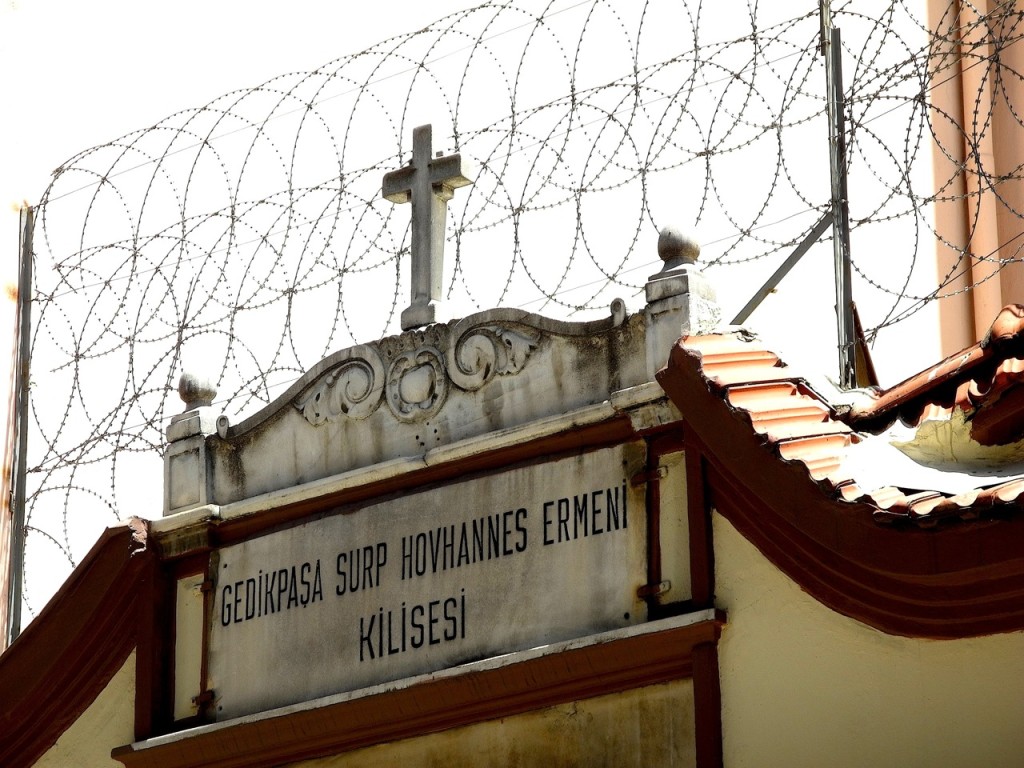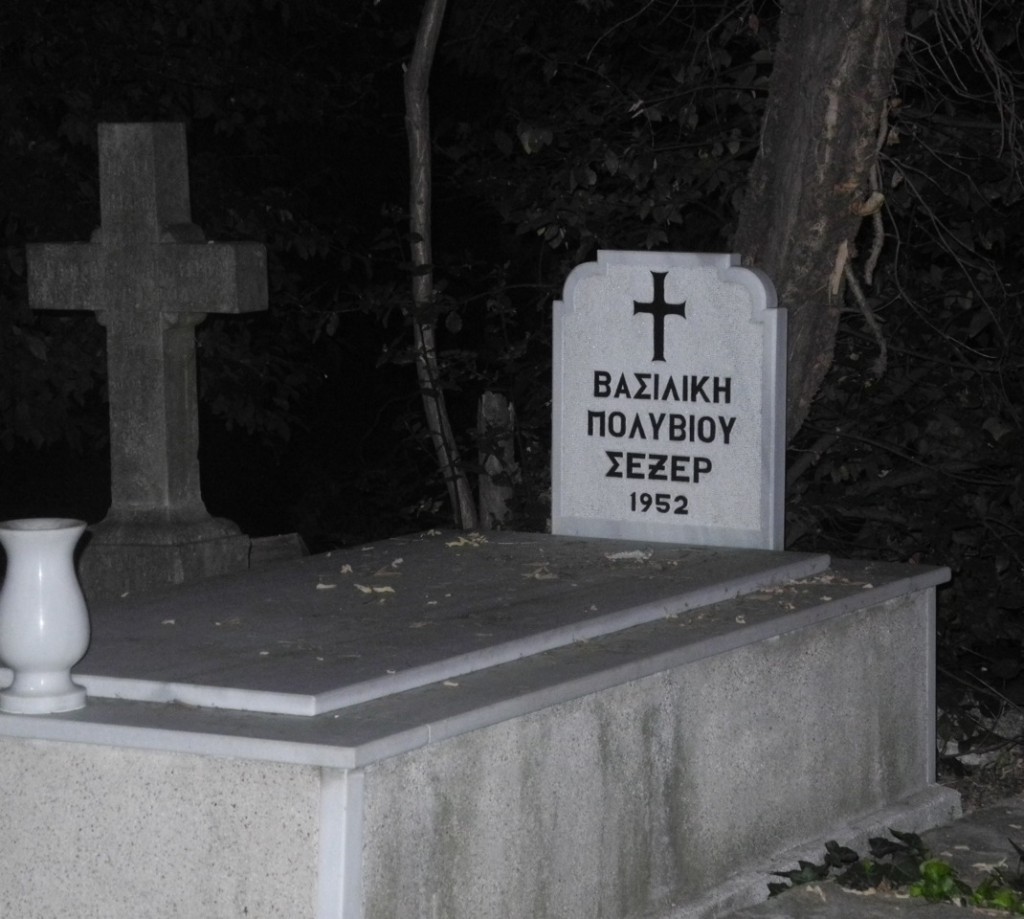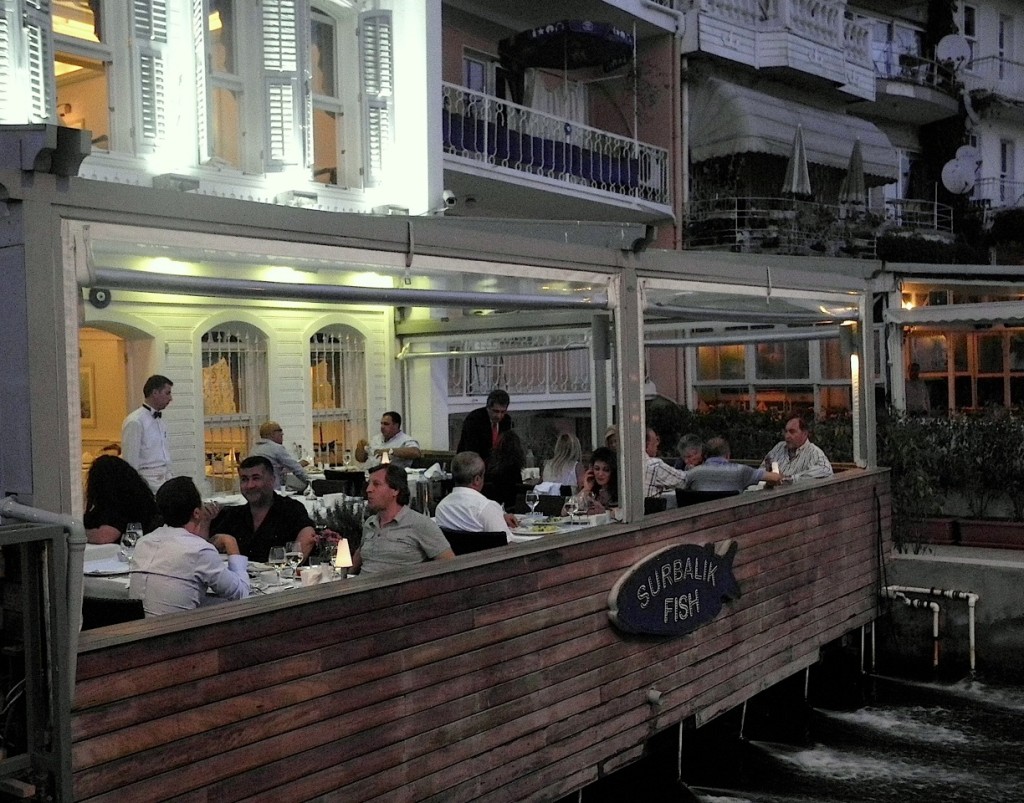
April 24, 2015 marks the 100th anniversary of the Armenian Genocide of 1915 at the hands of the Ottoman Empire in what is current-day Turkey. Anthropology Now is pleased to share this piece on contemporary Turkey and reflections on the genocide by journalist Mary D’Ambrosio.
We’d disturbed them at dinner, and they leapt up in surprise. We apologized, but walked resolutely past. After all, this was an ethnic Greek cemetery, and a quasi-public place. Rather, it was this family, one of many migrating to Istanbul from poor villages along the Black Sea, that had taken liberties. They were treating this graveyard like their backyard; they’d set up a whole outdoor room, in fact, right inside the cemetery gate.
I wasn’t sure what upset me more: the desecration, or the historical wrong. This year marks the hundredth anniversary of the worst anti-minority event in Turkish history: the 1915 expulsions and massacres of more than a million and a half ethnic Armenians, events most historians consider a genocide. I was surprised that, during the month I spent in Istanbul last summer, these events had been so infrequently mentioned. I’d expected at least a few commemorations and proclamations. But mostly, I’d sensed wary public silence.
My journalism students and I had come to this cemetery to look for vestiges of old cosmopolitan Constantinople, a multicultural space that existed mainly in Ottoman times. It was the sort of assignment I often gave my students in the United States: to chronicle life in a changing neighborhood. There as here, the rise of one group often meant the burial of another.
Turkey’s persecution of its Armenian residents intensified as the Ottoman Empire was collapsing, and the ruling Young Turk regime feared the Christian Armenians would help the Western powers carve up its territory. About three quarters of Turkey’s pre- 1915 Armenian population of 2 million disappeared: people were sent on forced death marches into the Syrian desert, and died or were killed along the way; were worked to death on labor battalions; or were murdered outright.
When it came to multicultural enfranchisement for the sake of its own survival, the Ottoman Empire was far cannier than the successor Turkish republic, with its narrow survivalist credo of “Turkey for the Turks.” That philosophy would justify depredations that followed: the driving out of Turkey’s ethnic Greek population in 1923, in a “population exchange” that was considered, back then, an enlightened way to encourage peace (it was the model for the Hindu-Muslim population exchanges that led to the establishment of Pakistan). That traumatic exchange became the template for subsequent anti-minority moves: an extortionate 1943 “Wealth Tax” on religious minorities, which soon encouraged tens of thousands of Jews to emigrate to the new state of Israel; and anti-minority riots in the mid-1950s, which pressed many of Turkey’s remaining ethnic Greeks to flee.
How long would it be until nothing of Armenian, Jewish or ethnic Greek culture could be seen in the city, I wondered, or even recalled? President Recep Tayyip Erdogan’s fervid urban modernization campaign was obliterating ex-minority neighborhoods at a blistering clip, with his xenophobic pro-Muslim rhetoric acting as a chaser. I wanted to get a last glimpse of those disappearing worlds.
Like the one I’d experienced in cemetery, where I discovered that the settlers didn’t mind dining on the heads of the dead.

“Please Don’t Take Our Picture”
The commuter train used to stop in Samatya, the seat of Istanbul’s Armenian community for more than 500 years. But as in the Trip to Bountiful, the train doesn’t go there any more. Now the sleek new Marmary rail line, more oriented toward tourist routes, has taken over the tracks.
“Bus,” the train station ticket agent said, waving her hand dismissively toward the street.
They’ve changed the neighborhood’s name, too, to Kocamustafapaşa, though many people go on stubbornly calling it by its old Byzantine name.
These have been especially nervewracking years for Turkey’s 60,000 remaining Armenians, after the 2007 assassination of ethnic Armenian newspaper editor Hrant Dink. Dink had dared to raise questions about the verboten G-word (the government maintains the 1915 Armenian deaths did not comprise a “genocide,” but were unfortunate casualties of war) – and had paid for his candor with his life. In 2013 there was a spate of attacks on elderly Samatya women, one of whom died. Though these incidents were widely suspected of being linked to ethnic intimidation, the authorities charged an Armenian they said was mentally disturbed.
Locals find it safest to agree with the official narrative. Several men at the café across the street from the church were quick to pronounce these “drug crimes.”
“The man was sniffing glue,” said one. He was 72, and had moved here in 1968, from the eastern Anatolian village of Yozgat. “Looking for money,” he insisted. “He was a common criminal.”
Please don’t use my name, he added, with his next breath. And don’t take our picture. He never learned to speak Armenian – there was no Armenian language instruction available in Yozgat – and he doesn’t attend church.
He finds life in Samatya agreeable.
“We have no trouble here,” he repeated frequently. “No trouble.”
And this is a main thing to hope for if you are an ethnic minority today in Istanbul: no trouble.
But Dink’s widow and a group of his friends decided that willful forgetting was an ineffective survival strategy. They established the Hrant Dink Foundation, to pursue “cultural dialogue.” And they began by defiantly publishing first-person narratives of Turkish Armenians’ experiences in Turkey.
Armenian masses last for hours, and what I understand when I go to one, at the enormous church of Surp Asdvadzadzin (Holy Mother of God), behind a 15-foot high stone wall in the trendy seaside Kumkapı neighborhood, is that this is a language I have never in my life heard, or seen written down. The rites seem vaguely familiar – I even recognize the cadences of certain prayers – but I can’t make out a word. The priest wears an impressive crown, and magnificent white robes decorated with red and gold crosses. An assistant waves incense liberally around. As many as 15 singers and acolytes surround the altar at one point – roughly equal to the number of worshippers in church.
Armenians are now joined at masses by Ethiopians living nearby. On the main street leading to the church, we hear bursts of Arabic – many Syrian refugees are squatting in derelict buildings on the side streets — and see well-dressed Somalis and Sudanese immigrants passing by. This avenue has lately been nicknamed “Somalia Street.” Though they’ve been joined by recent Armenian immigrants, some from earthquake-ravaged areas of Armenia, I sense it won’t be long until the faint Armenian presence dissipates.

“My Grandmother Was Very Happy Here”
In the crumbling neighborhood of Fener, center of Greek life under the Ottomans, the Greek Orthodox Patriarchate hangs grimly on (in very reduced circumstance, when you consider that in Byzantine times, the Patriarchate was in the Hagia Sophia). Most of the old Greek financiers’ mansions have collapsed. Though we hear about a new influx of Greeks arriving in search of work, officially fewer than 2,500 ethnic Greeks are left in this city; the Sunday we visit, many in the pews are tourists.
The black-cassocked priest offers a theatrical mass, singing and carrying the icons through the church. The tourists, visiting the neighborhood where some of their parents and grandparents had grown up, lit candles, and kissed the icons.
“My grandmother lived here,” confided one elderly woman, as we prayed for those we’d lost. Tearing up, she grasped my arm. “She was very happy here.”
One great thing the Greeks indisputably taught the Ottomans, a people of warrior horsemen from the Asian steppe, was how to love the sea.
You can witness this in the Bosphorus seaside neighborhood of Arnavutköy, where Greeks who managed to stay after the 1923 population exchange began moving in the 1930s and ‘40s. Arnavutköy is still one of Istanbul’s loveliest neighborhoods, full of lacy, wedding cake-like 19th century houses, and home to the prestigious Robert College (now a high school), founded by an American missionary.
Many of Arnavutköy’s legendary fish restaurants are still run by the descendents of the original Greek owners. Yours might have windows overlooking the strait, and be cheesily decked out in seashells and model ships. Bouzouki music softly plays. You’ll be given a menu, or perhaps not: the traditional way is for the waiter to bring dainty dishes of meze — the word in both Greek and Turkish — to the table on a tray; you, or your host (for here one person invites another; there’s no splitting of bills) will choose favorites.
You are urged to try the freshest fish, regardless of favorites. Levrek (sea bass), palamut (bonito) and prized lüfer (bluefish) are served grilled, heads and tails on, with only lemon, onions and a bit of side salad. To serve fish in this unadorned manner states: “You see, this is fresh! We are not burying some substandard fish beneath layers of overpowering sauce!” (In truth, I find this unvarying presentation a little monotonous. It’s also pricey: I feel bad when I hear that our host at a recent feast had spent a quarter of his monthly salary on us.)
Yet even this Greek practice has been co-opted. Going out for a festive “fish dinner by the sea” is now considered a thoroughly Turkish tradition.
Five Hundred Years of Ladino
One can still visit several celebrated synagogues, and of course the Jewish museum, established to commemorate the 500th anniversary of the arrival of Sephardic Jews from Spain. After expulsion from Spain in 1492, more than 150,000 Jews were famously invited to Constantinople by the sultan, to help populate his new empire. An early 20th century imperial census counted more than 250,000 Jews. But today only about 20,000 Jews are left in Turkey; tens of thousands decamped to Israel, which counts more than 80,000 Turkish Jews as residents.
In Kuzguncuk, an upscale neighborhorhood memorialized as a place where Turks, Christians and Jews had lived together harmoniously, I knocked on the heavy door of the Beth Yaakov Synagogue. Any visitor must get permission from Istanbul’s Chief Rabbinate to visit a synagogue or burial ground, given the history of bombings and attacks on Jewish sites in Turkey. But permission had come relatively quickly, and the caretaker opened the door to an interior richly appointed in purples, magentas and blues.
I couldn’t speak Turkish, and my host couldn’t speak English. But, to my astonishment, he spoke a variant of Ladino, and so we were able to converse in an approximation of Spanish. I was incredulous: how had such a language, spoken by only a handful of people, survived for a half millennium? Though lovingly maintained, this synagogue was now far too big for its purpose: my host told me that only a half dozen Jews remained in Kuzguncuk.

Island Silences
On a warm evening in Buyukada, an island off Istanbul in the Marmara Sea and a onetime Christian minority retreat, we walk along a serene back lane to the home of Turkish friends. Yellow butterflies flutter down from the pines. Our friend Tayfur seizes a branch hanging over the road, heavy with vermillion bougainvillea.
“You used to see this all along the streets, in big bursts of color,” he recalled. “And from every house there was music, Greek taverna music, where they were singing and dancing.”
We pause to reflect upon the many things lost, from the tangible — the bright flowers spilling from hedges, the celebratory music, the salad of languages – and the less, such as an acceptance of separate yet generally neighborly communities, trading with, and learning from, one other. And of pride, of citizenship in a onetime empire that in its prime could command, shelter and influence human beings for a thousand miles around. Chronicling cultural absence is a slippery thing: if nearly everyone is gone, how much can be gleaned from those few left to tell? Tonight the streets are silent, and the next morning, a Sunday, the only sound of religion we hear is the Muslim call to prayer.
Tayfur’s daughter and her husband have bought an Armenian family’s derelict house, and have spectacularly restored it, in sandstone, marble and tile. Did the former owners suspect that, a century on, their descendants would not be here to enjoy this island, or this home? That, beyond the abandoned houses and crumbling monasteries on this and the other Princes Islands, their descendents would find barely a trace of their centuries of residence here? We stood on the wide terrace, looking out to sea, as the former owners must have, perhaps wondering what plots were being hatched against them in the powerful city on the horizon.
~~~~~~~~~~~~~~
Mary D’Ambrosio is an assistant professor of journalism at Central Connecticut State University, and the founding editor of Big World Magazine.



5 Responses
Hi Mary! GReat story! Painful to think about the many cultures that have been so mistreated and repressed
Only someone with a deep understanding of so many cultural strands could write such a lovely, layered essay.
Sir, it is even more amusing to find the word Armenian 63 times in the above meeoitnnd web site. The site gives indeed a very good and objective history of the area including Armenian kingdoms and civilizations. This is a good example of biased attitudes of some western circles about everything concerning the Turks. But not of Lord Kinross ! In his book Within the Taurus , he gives a more balanced account of the area and its history for the ones who care to read rather than repeating third hand sources.
Eye like a camera not an objective tool. The way the ‘gaze’ set, may turn into a distorted picture of reality. When one point his/her camera (or eye for that matters) to a point where one desires to draw an attention, may easily manipulate what really is out there.
This self-professed journalist/academician article does pretty much the same thing in this piece.
What justifies this bias? What is the agenda in here? Disproportionate gross misrepresentation is speaks the volume, more so than carefully framed ‘ derelict home’ or a ‘fortified walls of a church’ in the confines of pseudo objectivist’s objective, and clouded mind.
Regretfully,
Noticing genocide is “biased”?